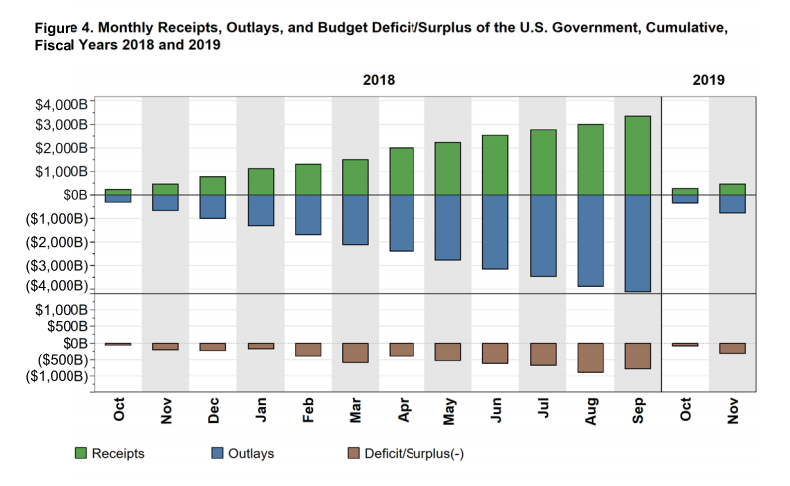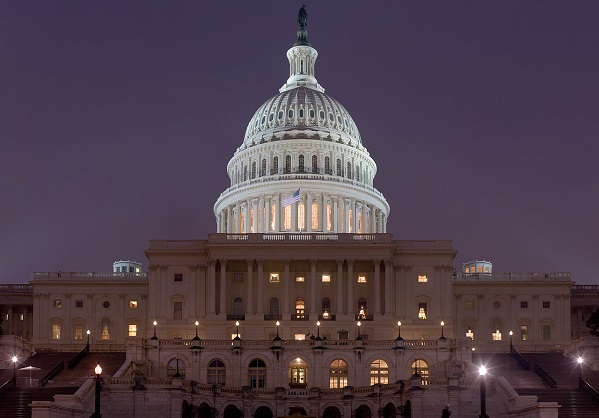Uncle Sam Runs Record $205 Billion Deficit in November
Washington D.C. just keeps right on spending.
The U.S. federal government ran a $204.9 billion deficit in November, according to the most recent Treasury Department report. That set a record for the month of November.
The November deficit came in $66.4 billion higher than last year’s imbalance. Although $44 billion of that figure reflects December benefits that were paid out in November this year because Dec. 1 fell on Saturday, that still represents a $22 billion year-on-year increase.
And November’s budget shortfall follows on the heels of a $100.5 billion deficit in October. Through the first two months of the 2019 budget year, the deficit totaled $305.4 billion. That’s a 51.4% increase over the first two months of fiscal 2018.
So far in fiscal 2019, revenues are up 3.4% over last year, coming in at $458.7 billion. But Uncle Sam has spent $764 billion over that last two months, an 18.4% increase over a year ago.

The federal government ended fiscal 2018 with the largest budget deficit since 2012. The budget year ended with Uncle Sam $779 billion in the red. The Treasury Department projects a $1.085 trillion deficit this year.
According to an AP report, the only other time the federal government has run deficits this high was during the four years from 2009 through 2012 when the Obama administration boosted spending to grapple with the 2008 financial crisis.
Although the economy is supposedly in the midst of a boom, US government borrowing looks more like we’re in the midst of a deep recession. Long-term US debt sales have risen to a level not seen since the height of the financial crisis. In November alone, the US Treasury sold over $200 billion in public debt. The government spent $33 billion simply paying the interest on outstanding loans.
The widening deficits add to a ballooning national debt that expanded by more than $1 trillion in fiscal 2018. The debt currently stands at over $21.85 trillion. According to data released by the Treasury Department, fiscal 2018 gave us the sixth-largest fiscal-year debt increase in the history of the United States. (If you’re wondering how the debt can grow by a larger number than the annual deficit, economist Mark Brandly explains here.)
The debt has grown by $1.9 trillion since president Trump took office.

Annual interest payments already approach $500 billion. Every uptick in the interest rate increases that number. At the current trajectory, the cost of paying the annual interest on the US debt will equal the annual cost of Social Security within 30 years.
This is not good news for the US economy. As we have reported repeatedly, large levels of debt retard economic growth.
Several studies have estimated that economic growth slows by about 30% when the debt to GDP ratio rises about 90%. Most analysts say the US economy is already in the 105% range.
Get Peter Schiff’s most important Gold headlines once per week – click here – for a free subscription to his exclusive weekly email updates.
Interested in learning how to buy gold and buy silver?
Call 1-888-GOLD-160 and speak with a Precious Metals Specialist today!





 Since Nayib Bukele became president of El Salvador, El Salvador has been in American media and global political discussion more than ever. While much of the attention focuses on Bukele’s mass incarceration of gang members and a decline in homicide of over 70%, Bukele has also drawn attention to his favoritism towards Bitcoin and how he […]
Since Nayib Bukele became president of El Salvador, El Salvador has been in American media and global political discussion more than ever. While much of the attention focuses on Bukele’s mass incarceration of gang members and a decline in homicide of over 70%, Bukele has also drawn attention to his favoritism towards Bitcoin and how he […] With gold hitting yet another awe-inspiring all-time high in the wake of Powell’s remarks reassuring markets (more or less) to expect rate cuts in 2024, a few analysts are pointing out risk factors for a correction — so is there really still room to run?
With gold hitting yet another awe-inspiring all-time high in the wake of Powell’s remarks reassuring markets (more or less) to expect rate cuts in 2024, a few analysts are pointing out risk factors for a correction — so is there really still room to run? Gold hit a new all-time nominal high, surpassing the previous record set in December of the previous year. The precious metal’s price reached approximately $2,140, indicating a robust and continuing interest in gold as a safe-haven asset, despite a rather peculiar lack of fanfare from the media and retail investors. This latest peak in gold […]
Gold hit a new all-time nominal high, surpassing the previous record set in December of the previous year. The precious metal’s price reached approximately $2,140, indicating a robust and continuing interest in gold as a safe-haven asset, despite a rather peculiar lack of fanfare from the media and retail investors. This latest peak in gold […] The gold price has been surging, with unprecedented central bank demand gobbling up supply. It has been a force to behold — especially as US monetary policy has been relatively tight since 2022, and 10-year Treasury yields have rocketed up, which generally puts firm downward pressure on gold against USD.
The gold price has been surging, with unprecedented central bank demand gobbling up supply. It has been a force to behold — especially as US monetary policy has been relatively tight since 2022, and 10-year Treasury yields have rocketed up, which generally puts firm downward pressure on gold against USD.  Total gold demand hit an all-time high in 2023, according to a recent report released by the World Gold Council. Last week, the World Gold Council (WGC) released its Gold Demand Trends report, which tracks developments in the demand for and use of gold around the world. Excluding over-the-counter (OTC) trade, 2023 gold demand fell slightly from 2022 […]
Total gold demand hit an all-time high in 2023, according to a recent report released by the World Gold Council. Last week, the World Gold Council (WGC) released its Gold Demand Trends report, which tracks developments in the demand for and use of gold around the world. Excluding over-the-counter (OTC) trade, 2023 gold demand fell slightly from 2022 […]